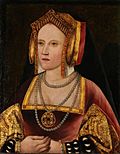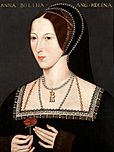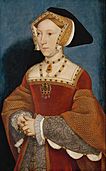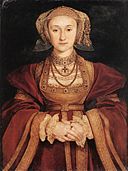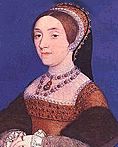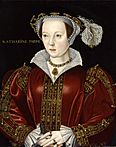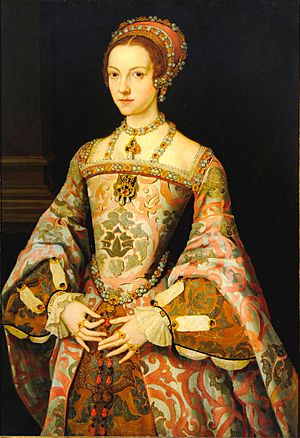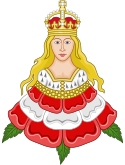Catherine Parr facts for kids
Quick facts for kids Catherine Parr |
|
|---|---|
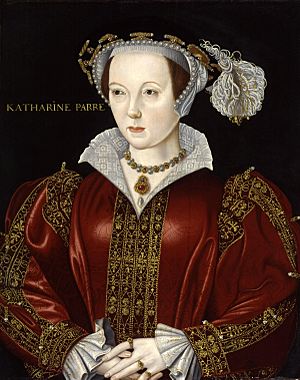 |
|
| Queen consort of England and Ireland | |
| Tenure | 12 July 1543 – 28 January 1547 |
| Born | 1512 Blackfriars, London, England |
| Died | 5 September 1548 (aged 35–36) Sudeley Castle, Gloucestershire, England |
| Burial | 7 September 1548 St Mary's Chapel, Sudeley Castle |
| Spouse |
Thomas Seymour, 1st Baron Seymour of Sudeley
(m. 1547) |
| Issue | Mary Seymour |
| Father | Sir Thomas Parr |
| Mother | Maud Green |
| Religion | Protestant |
| Signature |  |
Catherine Parr (born 1512 – died 5 September 1548) was the last of King Henry VIII's six wives. She was Queen of England and Ireland from their marriage on 12 July 1543 until Henry's death in 1547. Catherine was the final queen of the Tudor family. She lived for about a year and eight months after Henry died. She had four husbands, more than any other English queen. Catherine was also the first English queen to publish her own book in English.
Catherine had a good relationship with Henry's three children: Mary, Elizabeth, and Edward. She helped with Elizabeth's and Edward's education. Catherine also helped Henry VIII pass a law in 1543. This law, called the Third Succession Act, put his daughters Mary and Elizabeth back in line for the throne.
In 1544, Catherine was made regent (a temporary ruler) while Henry was fighting in France. If he had died, she would have ruled until Edward was old enough. However, Henry did not give her any power in his will. After the king's death, she became a guardian to her stepdaughter, Elizabeth.
Catherine published her first book, Psalms or Prayers, in 1544. Her second book, Prayers or Meditations, was the first book published by an English queen under her own name in 1545. She published a third book, The Lamentation of a Sinner, in 1547. Because she supported Protestantism, some officials who were against Protestants tried to turn the king against her. An order for her arrest was prepared in 1546. But she and the king soon made up.
After Henry VIII died in 1547, Catherine was allowed to keep the queen's jewels and dresses. About six months later, she married her fourth husband, Thomas Seymour, 1st Baron Seymour of Sudeley. He was King Edward VI's uncle. Catherine's last marriage was short. She died on 5 September 1548, after giving birth to her daughter. Her funeral was held on 7 September 1548. It was the first Protestant funeral in England to be held in English.
Contents
Catherine Parr's Early Life
Catherine Parr was born in 1512, probably in August. She was the oldest child of Sir Thomas Parr and Maud Green. Her father was a close friend of King Henry VIII. Catherine's mother was a good friend and helper to Henry VIII's first queen, Catherine of Aragon. Catherine Parr was likely named after Queen Catherine, who was her godmother.
It was once thought that Catherine was born at Kendal Castle. However, the castle was in poor condition then. Her parents were living in their London home in Blackfriars. So, historians now believe she was born in London. Catherine's father died when she was young. She was very close to her mother as she grew up.
Catherine's early education was like that of other well-born women. But she loved learning and continued to study throughout her life. She could speak French, Latin, and Italian. She started learning Spanish after she became queen.
First Marriage (1529–1533)
In 1529, when she was seventeen, Catherine married Sir Edward Burgh. He was in his twenties and may have been ill. He died in the spring of 1533.
Lady Latimer (1534–1543)
After her first husband died, Catherine married John Neville, 3rd Baron Latimer in 1534. He was her father's cousin and twice her age. Lord Latimer had two children, John and Margaret, from his first marriage. Catherine now had her own home and a title.

Latimer supported the Catholic Church. He was against King Henry's divorce from Catherine of Aragon. In 1536, during a rebellion called the Pilgrimage of Grace, Catholic rebels came to the Latimers' home. They threatened violence if Latimer did not join them. Catherine watched as her husband was taken away.
From October 1536 to April 1537, Catherine lived alone with her stepchildren. They struggled to survive. In January 1537, Catherine and her stepchildren were held hostage at Snape Castle. The rebels ransacked the house. They told Lord Latimer that they would kill his family if he did not return. When Latimer returned, he convinced the rebels to release his family. This difficult time likely made Catherine more supportive of the reformed Church of England.
The king wondered if Latimer was a prisoner or a rebel. If he was a rebel, he could be found guilty of treason. This would mean losing his lands and leaving Catherine and her stepchildren with nothing. Catherine's brother, William Parr, and her uncle, William Parr, 1st Baron Parr of Horton, fought against the rebellion. They likely helped save Latimer's life.
Latimer's reputation was damaged, but no charges were brought against him. The family spent much time in the south of England. In 1542, Catherine visited her brother and sister at court in London. There, she met Sir Thomas Seymour. The court was very different from the quiet country estates she knew. She saw the latest trends in religion, fashion, and jewelry.
By the winter of 1542, Lord Latimer's health got worse. Catherine cared for him until he died in 1543. In his will, Catherine was named guardian of his daughter, Margaret. She was left a wealthy widow.
Catherine renewed her friendship with Lady Mary, the daughter of Henry's first queen. By February 1543, Catherine was part of Mary's household. There, she caught the king's attention. Catherine had started a romantic friendship with Sir Thomas Seymour. But she felt it was her duty to accept Henry's marriage proposal instead. Seymour was sent to Brussels to keep him away from the king's court.
Queen of England and Ireland
(1509–1533)
(1533–1536)
(1536–1537)
(1540)
(1540–1542)
(1543–1547)
Catherine married Henry VIII on 12 July 1543 at Hampton Court Palace. She was the first Queen of England to also be Queen of Ireland. Catherine and Henry were distant cousins.
As queen, Catherine brought her former stepdaughter, Margaret Neville, to be her lady-in-waiting. She also gave positions in her household to her cousin and her stepson's wife. Catherine helped Henry make peace with his daughters, Mary and Elizabeth. She also became close with Henry's son, Edward. Her uncle, Lord Parr of Horton, became her Lord Chamberlain.
Catherine's book, Psalms or Prayers taken out of Holy Scriptures, was printed in April 1544. It was an anonymous translation of a Latin work. The book was a powerful piece of wartime writing. It was meant to help Henry win the war against France and Scotland through the prayers of his people. Catherine paid for special copies of the book to be given as gifts at court. One of the "Psalms" was even set to music by Thomas Tallis. Catherine's "A Prayer for the King" was later added to the Book of Common Prayer in 1559. It is still used today to pray for the British monarch.
Henry went on his last military campaign to France from July to September 1544. He left Catherine as his regent. Her council included people who supported her, like her uncle Thomas Cranmer. This gave Catherine real power to rule as she saw fit. She managed supplies, money, and soldiers for Henry's campaign. She signed five royal orders. She also stayed in touch with her lieutenant about the situation with Scotland. Her actions as regent, along with her strong character, likely influenced her stepdaughter Elizabeth.
Catherine's second book, Prayers or Meditations, came out in June 1545. It was also a bestseller. Princess Elizabeth translated this book into Latin, Italian, and French. She gave the translation to Henry VIII as a New Year's gift in December 1545.
Some anti-Protestant officials, like Stephen Gardiner and Lord Wriothesley, were suspicious of the queen's religious views. Catherine was raised Catholic, but she became interested in the "New Faith" (Protestantism). By the mid-1540s, people suspected she was a Protestant. This is supported by her strong Protestant ideas shown after Henry's death. Her third book, Lamentation of a Sinner, was published in late 1547.
In 1546, Gardiner and Wriothesley tried to turn the king against her. An arrest warrant was prepared for her. But Catherine saw the warrant and managed to make up with the king. She told him she had only argued about religion to distract him from the pain of his leg. The next day, an armed guard tried to arrest her. He did not know she had reconciled with the king.
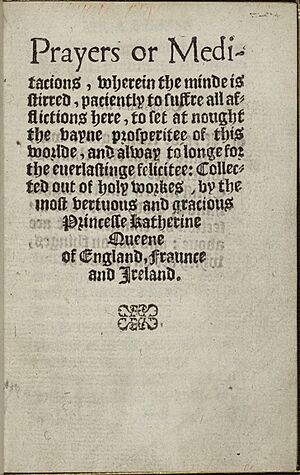
Final Marriage and Death
Before he died, Henry made sure Catherine would receive £7,000 a year. He also ordered that she should be treated with the respect of a queen, even after his death. Catherine left court after her stepson, Edward VI, became king in January 1547. She moved to her home in Chelsea.
After Henry's death, Catherine's old love, Thomas Seymour, returned to court. He was the new king's uncle. Catherine quickly agreed to marry him. Since only four months had passed since Henry's death, Seymour knew the King's council would not approve a quick marriage. So, Catherine and Seymour married in secret around May. King Edward VI and the council were not told for several months. When their marriage became public, it caused a small scandal. The king and Lady Mary were very unhappy.
Catherine also had arguments with her brother-in-law, Edward Seymour, 1st Duke of Somerset. He was also the king's uncle and the Lord Protector. A rivalry grew between Catherine and his wife, Anne Seymour, Duchess of Somerset. They argued about Catherine's jewels. The Duchess said Catherine, as the queen dowager, should no longer wear the jewels meant for the king's wife. She thought she, as the Protector's wife, should wear them. This argument damaged Catherine's relationship with the Duchess. It also made the relationship between the two Seymour brothers worse.
In November 1547, Catherine published her third book, The Lamentation of a Sinner. This book promoted the Protestant idea of justification by faith alone. This idea was considered heresy by the Catholic Church. In 1544 or 1545, Catherine had started to organize an English translation of Erasmus's Paraphrases Upon the New Testament. This large book was printed in January 1548. Catherine owned many books. She also wrote notes in her books and signed books that belonged to others.
At 35, Catherine became pregnant. This was a surprise, as she had not had children in her first three marriages. During this time, Seymour began to show interest in Lady Elizabeth. It was later reported that Catherine found them in a close moment. Elizabeth was sent away in May 1548 and never saw her stepmother again, though they wrote letters.
In June 1548, Catherine moved to Sudeley Castle in Gloucestershire. Lady Jane Grey went with her. Catherine promised to educate Lady Jane. Catherine spent the last months of her pregnancy and her last summer there.
Catherine gave birth to her only child, a daughter named Mary Seymour, on 30 August 1548. Catherine died on 5 September 1548, at Sudeley Castle. She likely died from "childbed fever". This illness was common because of poor hygiene during childbirth.
Catherine's funeral was held on 7 September 1548. It was the first Protestant funeral held in English. Lady Jane Grey was the chief mourner. Catherine was buried in St. Mary's Chapel at Sudeley Castle.
Thomas Seymour was executed for treason in March 1549. Mary Seymour went to live with the Dowager Duchess of Suffolk, a close friend of Catherine's. The last record of Mary Seymour is on her second birthday. Most historians believe she died as a child.
Catherine Parr's Burial Site
During the English Civil War, Sudeley Castle was used by King Charles I. It was attacked in 1643. Catherine's grave was likely disturbed then. The castle changed hands several times and was later abandoned. Catherine's royal grave was lost.
Her presence at the castle was rediscovered in 1768 by Rev. Huggett. In 1782, Joseph Lucas found her lost grave among the chapel ruins.
The coffin was opened several times between 1783 and 1792. In 1792, vandals broke into the coffin and threw the body into a rubbish heap. Mr. Lucas reburied the body in a hidden grave.
The coffin was last opened in 1817. By then, the body was just a skeleton. Fragments of Catherine's dress and locks of her hair were collected during these openings. Most of these items are now on display at Sudeley Castle.
In 1861, the coffin was moved to its final resting place. It is now in the restored chapel, under a beautiful tomb.
Portraits of Catherine Parr
A full-length portrait of Catherine Parr by Master John is in the National Portrait Gallery. For many years, people thought this painting was of Lady Jane Grey. But it has recently been correctly identified as Catherine Parr. Full-length portraits were rare then and usually only for very important people. Lady Jane Grey was only eight years old when this was painted (around 1545).
The crown-shaped jewel in the portrait can be found in a list of Catherine Parr's jewels. The cameo beads seem to have belonged to Catherine Howard, Henry VIII's previous queen. They would have passed to Catherine Parr when she became queen.
How Historians See Catherine Parr
Some people used to think Catherine Parr was more like Henry VIII's nurse than his wife. This idea came from a 19th-century writer. But historians like David Starkey disagree. They point out that Henry had many doctors. Catherine was expected to act with queenly dignity.
Historians admire Catherine's good sense, strong morals, kindness, and loyalty. They include David Starkey, Antonia Fraser, Alison Weir, and Linda Porter. Biographers describe her as strong-willed and outspoken.
See also
 In Spanish: Catalina Parr para niños
In Spanish: Catalina Parr para niños


